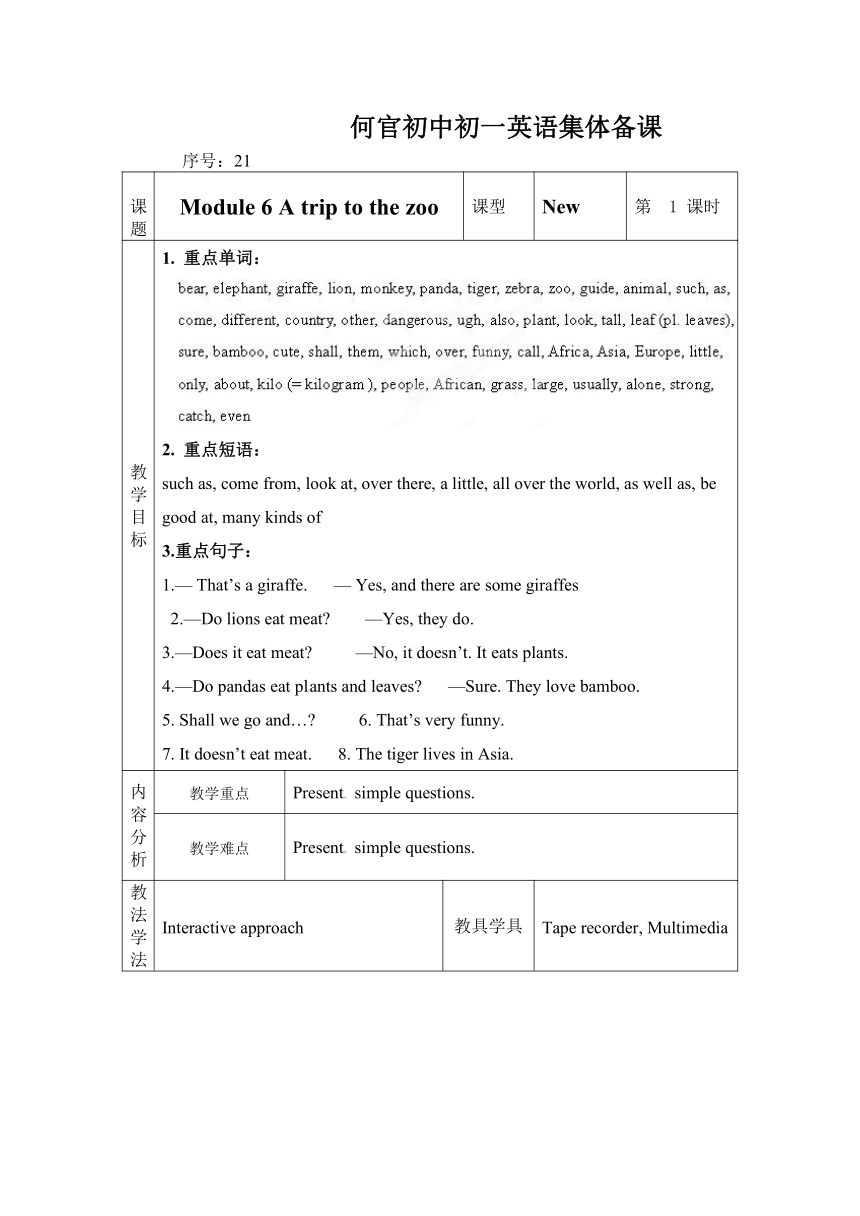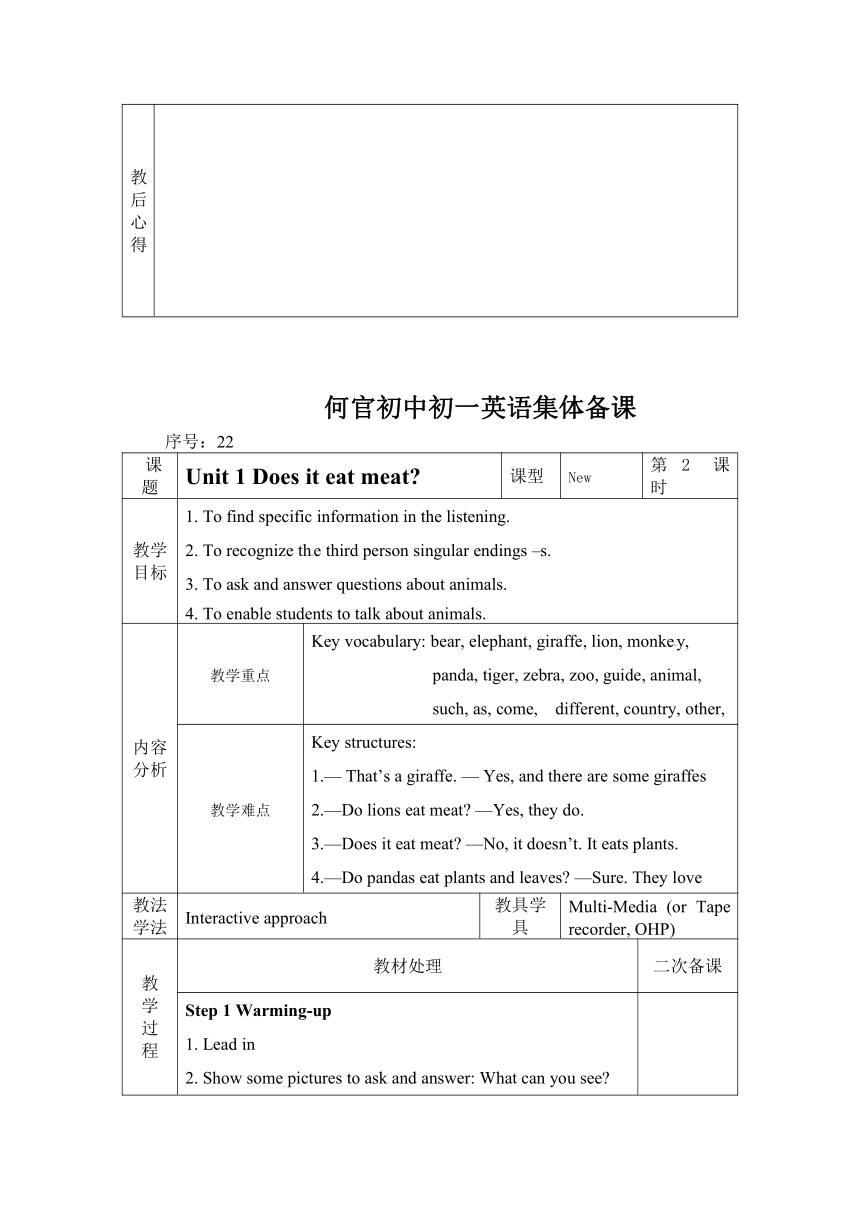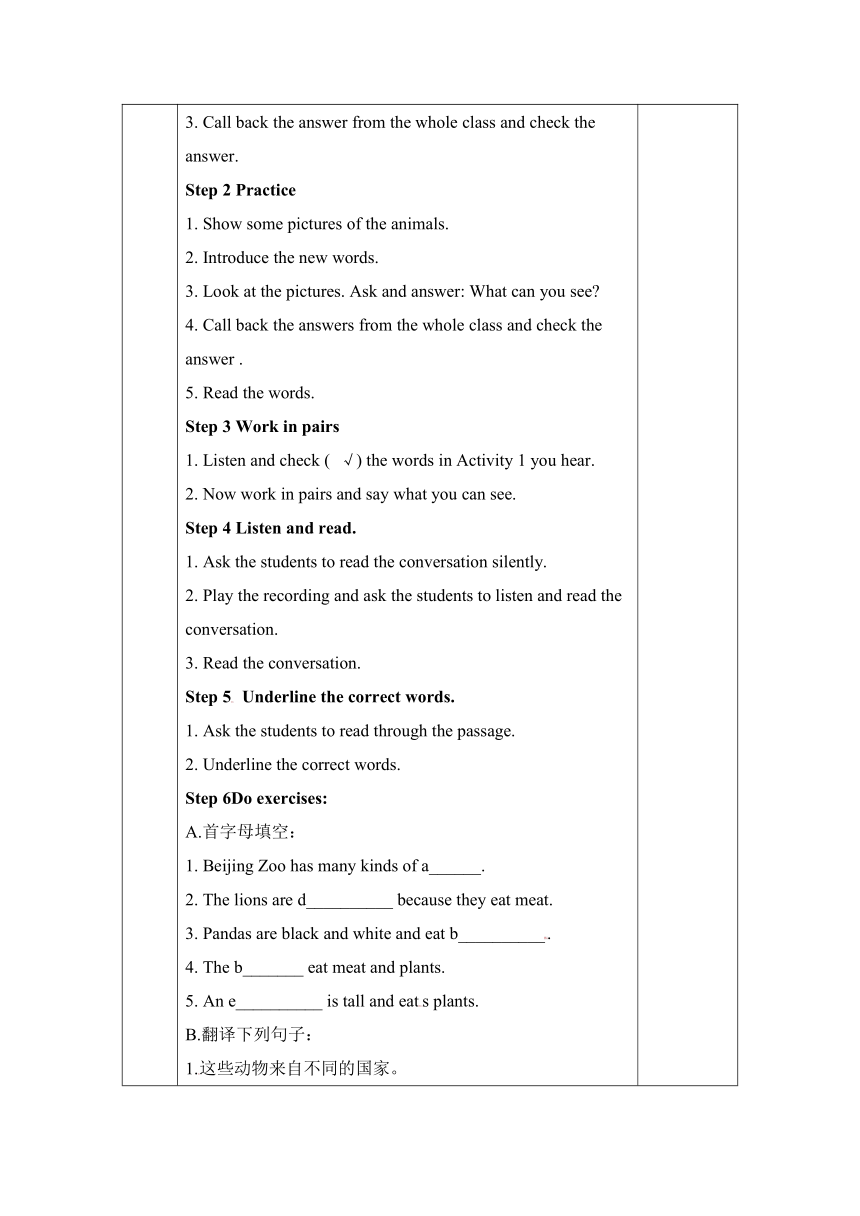Module 6 A trip to the zoo.模块教案
文档属性
| 名称 | Module 6 A trip to the zoo.模块教案 |  | |
| 格式 | zip | ||
| 文件大小 | 253.2KB | ||
| 资源类型 | 教案 | ||
| 版本资源 | 外研版 | ||
| 科目 | 英语 | ||
| 更新时间 | 2013-10-19 12:11:00 | ||
图片预览




文档简介
何官初中初一英语集体备课
序号:21
课题 Module 6 A trip to the zoo 课型 New 第 1 课时
教学目标 1. 重点单词:2. 重点短语:such as, come from, look at, over there, a little, all over the world, as well as, be good at, many kinds of3.重点句子:1.— That’s a giraffe. — Yes, and there are some giraffes2.—Do lions eat meat —Yes, they do.3.—Does it eat meat —No, it doesn’t. It eats plants.4.—Do pandas eat plants and leaves —Sure. They love bamboo.5. Shall we go and… 6. That’s very funny.7. It doesn’t eat meat. 8. The tiger lives in Asia.
内容分析 教学重点 Present simple questions.
教学难点 Present simple questions.
教法学法 Interactive approach 教具学具 Tape recorder, Multimedia
教后心得
何官初中初一英语集体备课
序号:22
课题 Unit 1 Does it eat meat 课型 New 第 2 课时
教学目标 1. To find specific information in the listening.2. To recognize the third person singular endings –s.3. To ask and answer questions about animals.4. To enable students to talk about animals.
内容分析 教学重点 Key vocabulary: bear, elephant, giraffe, lion, monkey, panda, tiger, zebra, zoo, guide, animal, such, as, come, different, country, other, dangerous, ugh, also, plant, look, tall, leaf (pl. leaves), sure, bamboo, cute, shall, them, which, over, funny, call
教学难点 Key structures: 1.— That’s a giraffe. — Yes, and there are some giraffes2.—Do lions eat meat —Yes, they do.3.—Does it eat meat —No, it doesn’t. It eats plants.4.—Do pandas eat plants and leaves —Sure. They love bamboo.5. Shall we go and… 6. That’s very funny.
教法学法 Interactive approach 教具学具 Multi-Media (or Tape recorder, OHP)
教学过程 教材处理 二次备课
Step 1 Warming-up1. Lead in2. Show some pictures to ask and answer: What can you see 3. Call back the answer from the whole class and check the answer.Step 2 Practice1. Show some pictures of the animals. 2. Introduce the new words.3. Look at the pictures. Ask and answer: What can you see 4. Call back the answers from the whole class and check the answer .5. Read the words.Step 3 Work in pairs1. Listen and check ( √) the words in Activity 1 you hear.2. Now work in pairs and say what you can see.Step 4 Listen and read.1. Ask the students to read the conversation silently.2. Play the recording and ask the students to listen and read the conversation.3. Read the conversation.Step 5 Underline the correct words.1. Ask the students to read through the passage.2. Underline the correct words.Step 6Do exercises:A.首字母填空:1. Beijing Zoo has many kinds of a______.2. The lions are d__________ because they eat meat.3. Pandas are black and white and eat b__________.4. The b_______ eat meat and plants.5. An e__________ is tall and eats plants.B.翻译下列句子:1.这些动物来自不同的国家。_____________________________________.2.老虎爱吃肉吗?__________________________________ Step 10 Homework1 Learn the new words by heart.2 Read and act out the dialogue.
教后心得
何官初中初一英语集体备课
序号:23
课题 Unit 2 The tiger lives in Asia. 课型 New 第 3 课时
教学目标 1. To get information about animals from the reading material.2. To learn to find specific information in the reading.3. To learn to use capital letters.
内容分析 教学重点 Key vocabulary: Africa, Asia, Europe, little, only, kilo (= kilogram ), people, African, grass, large, usually, alone, strong, catch, even, world
教学难点 To improve the Ss’ reading ability.
教法学法 Interactive approach 教具学具 Multi-Media (or Tape recorder, OHP)
教学过程 教材处理 二次备课
Step 1 Warming-up1. Review the text of Unit 1. 2. Introduce the new words.3. Read the new words.Step 2 Find these places on the map. 1. Show a map of the world.2. Find these places (Africa, America, Asia, Europe)on the map. Step 3 Reading.1. Play the recording.2. Ask the students to read through the passage.3. Read the passage and complete the table in Activity 3.4. Check with a partner.5. Call back the answers from the whole class.6. Complete the sentences with the correct form of the words and expression from the box in Activities 4.7. Check with a partner.8. Call back the answers from the whole class.Step 4 Writing.1. Read the introduction about a zoo.2. Correct the mistakes. 3. Ask the students to notice capital letters. The zoo has many animals. The animals come from many different countries. The panda lives in China and it eats bamboo. There are elephants from Africa and Asia. The tiger comes from Asia. It eats meat.Step 5 Do exercises:A.首字母填空:1. China is a country in A___________.2. They are Europeans. They come from E_______.3. The dog is my favourite a _________.4. In autumn, we can see the yellow l__________ of the trees.5. The old man lives a________. I usually talk with him.B..综合填空:Susan likes animals very much. She often goes to the zoo with her parents. (1)T_____ are many animals in the zoo. Such as (2)g______ , (3)t______ and many more. (4)P____ like eating bamboo, (5) e_______ are very big and strong, they have long noses and they like (6) d_____ water. (7) M_______ are Susan’s favourite animal. They like eating bananas and climbing trees. Susan doesn’t like (8) l______ because they are very dangerous. The (9) g______ tells the family the kind of animals are from (10)E_______. But her parents like them very much. Susan always has a good time too.
教后反思
何官初中初一英语集体备课
序号:24
课题 Unit 3 Language in use 课型 New 第 4 课时
教学目标 1. To summarise and consolidate Present simple questions.2. To know something about animals in China.3. To have teamwork and make a poster of one’s favourite animal.
内容分析 教学重点 Key structures: It doesn’t eat meat. Does it eat meat No, it doesn’t. It eats plants.The tiger lives in Asia.
教学难点 To improve the Ss’ writing ability.
教法学法 Interactive approach 教具学具 Multi-Media (or Tape recorder, OHP)
教学过程 教材处理 二次备课
Step 1 RevisionShow some pictures to review the text of Unit 1 and Unit 2 .Step 2 Language practice1. Read through the example sentences in the box with the whole class.2. Ask the students to repeat the sentences in the box.3. Grammar : The present simpleStep 3 Work in pairs1. Look at the pictures. Ask: What can you see 2. Ask and answer with a partner.3. Call back the answers from the whole class, check the answers.Step 4 Complete the sentences with does or doesn’t. 1. Read through the sentences with the whole class.2. Ask the students to Complete the sentences with a partner.3. Call back the answers from the whole class, check the answers.Step 5 Important and difficult points.行为动词一般现在时的疑问式和回答一般现在时的疑问式在句首加助动词do, 主语为第三人称单数时在句首加does,其结构是:1.Do + 主语+ 动词原形… They live near our school.Do they live near our school The students like learning English.Do the students like learning English 2.Does + 主语(第三人称单数)+ 动词原形… He watches TV every evening.Does he watch TV every evening My father teaches Chinese.Does your father teach Chinese 3.简略回答用助动词do / does 和don’t / doesn’t 代替行为动词。—Do you often go shopping with your mother —Yes, I do. / No, I don’t.—Does his mother work in that factory —Yes, she does. / No, she doesn’t.
教后反思
序号:21
课题 Module 6 A trip to the zoo 课型 New 第 1 课时
教学目标 1. 重点单词:2. 重点短语:such as, come from, look at, over there, a little, all over the world, as well as, be good at, many kinds of3.重点句子:1.— That’s a giraffe. — Yes, and there are some giraffes2.—Do lions eat meat —Yes, they do.3.—Does it eat meat —No, it doesn’t. It eats plants.4.—Do pandas eat plants and leaves —Sure. They love bamboo.5. Shall we go and… 6. That’s very funny.7. It doesn’t eat meat. 8. The tiger lives in Asia.
内容分析 教学重点 Present simple questions.
教学难点 Present simple questions.
教法学法 Interactive approach 教具学具 Tape recorder, Multimedia
教后心得
何官初中初一英语集体备课
序号:22
课题 Unit 1 Does it eat meat 课型 New 第 2 课时
教学目标 1. To find specific information in the listening.2. To recognize the third person singular endings –s.3. To ask and answer questions about animals.4. To enable students to talk about animals.
内容分析 教学重点 Key vocabulary: bear, elephant, giraffe, lion, monkey, panda, tiger, zebra, zoo, guide, animal, such, as, come, different, country, other, dangerous, ugh, also, plant, look, tall, leaf (pl. leaves), sure, bamboo, cute, shall, them, which, over, funny, call
教学难点 Key structures: 1.— That’s a giraffe. — Yes, and there are some giraffes2.—Do lions eat meat —Yes, they do.3.—Does it eat meat —No, it doesn’t. It eats plants.4.—Do pandas eat plants and leaves —Sure. They love bamboo.5. Shall we go and… 6. That’s very funny.
教法学法 Interactive approach 教具学具 Multi-Media (or Tape recorder, OHP)
教学过程 教材处理 二次备课
Step 1 Warming-up1. Lead in2. Show some pictures to ask and answer: What can you see 3. Call back the answer from the whole class and check the answer.Step 2 Practice1. Show some pictures of the animals. 2. Introduce the new words.3. Look at the pictures. Ask and answer: What can you see 4. Call back the answers from the whole class and check the answer .5. Read the words.Step 3 Work in pairs1. Listen and check ( √) the words in Activity 1 you hear.2. Now work in pairs and say what you can see.Step 4 Listen and read.1. Ask the students to read the conversation silently.2. Play the recording and ask the students to listen and read the conversation.3. Read the conversation.Step 5 Underline the correct words.1. Ask the students to read through the passage.2. Underline the correct words.Step 6Do exercises:A.首字母填空:1. Beijing Zoo has many kinds of a______.2. The lions are d__________ because they eat meat.3. Pandas are black and white and eat b__________.4. The b_______ eat meat and plants.5. An e__________ is tall and eats plants.B.翻译下列句子:1.这些动物来自不同的国家。_____________________________________.2.老虎爱吃肉吗?__________________________________ Step 10 Homework1 Learn the new words by heart.2 Read and act out the dialogue.
教后心得
何官初中初一英语集体备课
序号:23
课题 Unit 2 The tiger lives in Asia. 课型 New 第 3 课时
教学目标 1. To get information about animals from the reading material.2. To learn to find specific information in the reading.3. To learn to use capital letters.
内容分析 教学重点 Key vocabulary: Africa, Asia, Europe, little, only, kilo (= kilogram ), people, African, grass, large, usually, alone, strong, catch, even, world
教学难点 To improve the Ss’ reading ability.
教法学法 Interactive approach 教具学具 Multi-Media (or Tape recorder, OHP)
教学过程 教材处理 二次备课
Step 1 Warming-up1. Review the text of Unit 1. 2. Introduce the new words.3. Read the new words.Step 2 Find these places on the map. 1. Show a map of the world.2. Find these places (Africa, America, Asia, Europe)on the map. Step 3 Reading.1. Play the recording.2. Ask the students to read through the passage.3. Read the passage and complete the table in Activity 3.4. Check with a partner.5. Call back the answers from the whole class.6. Complete the sentences with the correct form of the words and expression from the box in Activities 4.7. Check with a partner.8. Call back the answers from the whole class.Step 4 Writing.1. Read the introduction about a zoo.2. Correct the mistakes. 3. Ask the students to notice capital letters. The zoo has many animals. The animals come from many different countries. The panda lives in China and it eats bamboo. There are elephants from Africa and Asia. The tiger comes from Asia. It eats meat.Step 5 Do exercises:A.首字母填空:1. China is a country in A___________.2. They are Europeans. They come from E_______.3. The dog is my favourite a _________.4. In autumn, we can see the yellow l__________ of the trees.5. The old man lives a________. I usually talk with him.B..综合填空:Susan likes animals very much. She often goes to the zoo with her parents. (1)T_____ are many animals in the zoo. Such as (2)g______ , (3)t______ and many more. (4)P____ like eating bamboo, (5) e_______ are very big and strong, they have long noses and they like (6) d_____ water. (7) M_______ are Susan’s favourite animal. They like eating bananas and climbing trees. Susan doesn’t like (8) l______ because they are very dangerous. The (9) g______ tells the family the kind of animals are from (10)E_______. But her parents like them very much. Susan always has a good time too.
教后反思
何官初中初一英语集体备课
序号:24
课题 Unit 3 Language in use 课型 New 第 4 课时
教学目标 1. To summarise and consolidate Present simple questions.2. To know something about animals in China.3. To have teamwork and make a poster of one’s favourite animal.
内容分析 教学重点 Key structures: It doesn’t eat meat. Does it eat meat No, it doesn’t. It eats plants.The tiger lives in Asia.
教学难点 To improve the Ss’ writing ability.
教法学法 Interactive approach 教具学具 Multi-Media (or Tape recorder, OHP)
教学过程 教材处理 二次备课
Step 1 RevisionShow some pictures to review the text of Unit 1 and Unit 2 .Step 2 Language practice1. Read through the example sentences in the box with the whole class.2. Ask the students to repeat the sentences in the box.3. Grammar : The present simpleStep 3 Work in pairs1. Look at the pictures. Ask: What can you see 2. Ask and answer with a partner.3. Call back the answers from the whole class, check the answers.Step 4 Complete the sentences with does or doesn’t. 1. Read through the sentences with the whole class.2. Ask the students to Complete the sentences with a partner.3. Call back the answers from the whole class, check the answers.Step 5 Important and difficult points.行为动词一般现在时的疑问式和回答一般现在时的疑问式在句首加助动词do, 主语为第三人称单数时在句首加does,其结构是:1.Do + 主语+ 动词原形… They live near our school.Do they live near our school The students like learning English.Do the students like learning English 2.Does + 主语(第三人称单数)+ 动词原形… He watches TV every evening.Does he watch TV every evening My father teaches Chinese.Does your father teach Chinese 3.简略回答用助动词do / does 和don’t / doesn’t 代替行为动词。—Do you often go shopping with your mother —Yes, I do. / No, I don’t.—Does his mother work in that factory —Yes, she does. / No, she doesn’t.
教后反思
同课章节目录
- Starte
- Module 1 My teacher and my friends
- Module 2 My English lesson
- Module 3 My English book
- Module 4 My everyday life
- Module 1 My classmates
- Unit 1 Nice to meet you.
- Unit 2 I'm Wang Lingling and I'm thirteen years ol
- Unit 3 Language in use.
- Module 2 My family
- Unit 1 Is this your mum?
- Unit 2 These are my parents.
- Unit 3 Language in use.
- Module 3 My school
- Unit 1 There are thirty students in my class.
- Unit 2 The library is on the left of the playgroun
- Unit 3 Language in use.
- Module 4 Healthy food
- Unit 1 We've got lots of apples.
- Unit 2 Is your food and drink healthy?
- Unit 3 Language in use.
- Module 5 My school day
- Unit 1 I love history.
- Unit 2 We start work at nine o'clock.
- Unit 3 Language in use.
- Revision module A
- Module 6 A trip to the zoo
- Unit 1 Does it eat meat?
- Unit 2 The tiger lives in Asia.
- Unit 3 Language in use.
- Module 7 Computers
- Unit 1 How do I write my homework on the computer?
- Unit 2 When do you use a computer?
- Unit 3 Language in use.
- Module 8 Choosing presents
- Unit 1 I always like birthday parties.
- Unit 2 She often goes to concerts.
- Unit 3 Language in use.
- Module 9 People and places
- Unit 1 We're enjoying the school trip a lot.
- Unit 2 They're waiting for buses or trains.
- Unit 3 Language in use.
- Module 10 Spring Festival
- Unit 1 Are you getting ready for Spring Festival?
- Unit 2 My mother's cleaning our houses and sweepin
- Unit 3 Language in use.
- Revision module B
